Fitness gurus and ‘muscular Christianity’: how Victorian Britain anticipated today’s keep fit craze
The Victorian era is often remembered as an age of industrial innovation, staunch morals and hard work. When we imagine the stereotypical Victorian, we often picture stiff collars and heavy, head-to-toe dresses – not celebrity weightlifters or homemakers practising callisthenics. But it turns out our obsession with physical fitness isn’t just because of 20th-century stars like Jane Fonda, Arnold Schwarzenegger, and Dwayne “The Rock” Johnson. In fact, the Victorian age saw the beginnings of modern celebrity fitness culture and new forms of exercise – which we might credit for our current obsession today.
The Victorian fitness craze might first be traced back to the publication of Donald Walker’s book “British Manly Exercises” in 1837. The book included diagrams showing proper rowing technique, horse-riding instructions and detailed guidance on how to lunge, vault and wrestle. Walker also included exercises borrowed from different cultures, such as strength training using clubs from India which offered “the most effectual kinds of athletic training known anywhere”, according to a British officer stationed in the country. These forms of exercise quickly became popular, often because they were adopted by the British military.
Achieving physical fitness gradually became a cornerstone of Victorian values. This was largely inspired by cultural trends such as “Muscular Christianity”, which originated in England in the mid-19th century. Muscular Christianity emphasised the importance of training the body to reflect devotion to both God and society.
One author claimed that strong Christian bodies could be used to protect the weak, advance all “righteous causes”, and promote the “subduing of the earth which God has given to the children of men”.
Home exercise
Although hobbies such as riding horses and playing golf remained popular with the upper class, exercise done at home became increasingly favoured by the emerging Victorian middle class. “The Portable Gymnasium” became a bestseller after it was published in 1861. It claimed there were numerous benefits to undertaking what the author called “gymnastic exercises”, which were said to develop and restore the human form. Some of these exercises look similar to what we’d do today. Readers were instructed to use the portable gymnasium to perform body-toning exercises such as lateral extensions and head rotations.
Exercise had grown so popular that by 1865, the Royal Patent Gymnasium – a huge outdoor gym – was opened in Edinburgh. It regularly attracted thousands of fitness fanatics each day. It featured The Giant Sea Serpent, an enormous circular rowing machine which could reportedly seat 600 people at a time.
By the late 19th century, James Cantlie, a Scottish medical practitioner, had developed “new” exercise regimes that could be done at home. These included an elaborate routine of stretches to be performed morning and evening – accompanied by bathing and muscle massage.
Cantlie argued that they were especially suitable for the over-50s as they did not cause too much exertion. He also founded the British Institute of Physical Training in 1889, where men and women, young and old, could attend exercise classes where they would practice Cantlie’s so-called “physical jerks” – rhythmic movements to strengthen and tone the body.
 People were encouraged to do exercises at home. Internet Archive Book Images/ Flickr, CC BY
People were encouraged to do exercises at home. Internet Archive Book Images/ Flickr, CC BY
People who came to the classes were encouraged to practice the exercises at home on a daily basis – but were simultaneously warned they needed to return regularly to learn new exercises and ensure they were using the correct techniques. Cantlie also made other lifestyle recommendations, such as insisting that wearing kilts promoted “the health and strength of lads” as they didn’t restrict the body’s natural movements.
Cantlie’s system was just one among many other competing exercise regimes. However, his system served as inspiration for the daily exercise regime members of the Outer Party were required to do in George Orwell’s “1984” more than half a century later.
Other popular approaches to fitness and health included a regime developed by one Dr E H Ruddock, whose book Vitalogy (1899), promoted good posture, “vitativeness” (love for life), and only moderate exercise to avoid overtiring the body.
Fitness “influencers”
The Victorian age also saw the rise of the celebrity fitness guru. At the end of the 19th century, one of the most famous was German-born Eugen Sandow. Sandow staged elaborate strongman shows throughout Europe and America and built up a global publishing empire through his magazine Physical Culture, which included profiles and images of bodybuilders and articles on the merits of different exercises. He credited his approach to exercise, built around dumbbell training, with transforming his physique – and recreated poses from classical Roman and Greek sculpture to showcase his body.
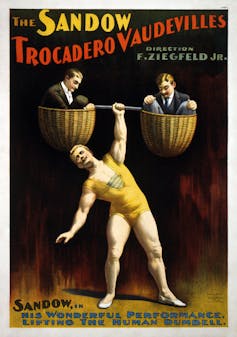 A poster of Eugen Sandow lifting the human dumbbell. US Library of Congress Prints
A poster of Eugen Sandow lifting the human dumbbell. US Library of Congress Prints
Sandow was a trailblazer who inspired others, including the American bodybuilder Bernarr Macfadden. Just a year younger than Sandow, Macfadden claimed that he was weak and sickly as a child. He argued in his first book, Macfadden’s Physical Training, which was published in 1900, that through a carefully managed vegetarian diet and regular weightlifting, anyone could overcome ill health, just as he had done. His system had specific guidance for young men, young women, middle-aged men and middle-aged women, and appropriate exercises “as the years wane”, all to be performed at home using his simple stretching device.
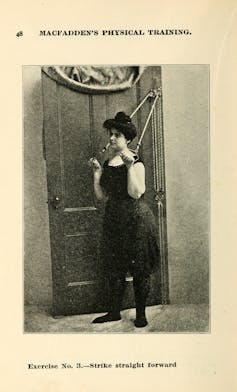 A woman uses Bernarr Macfadden’s exercise apparatus. Bernarr A. Macfadden, Macfadden's Physical Training, 1900
A woman uses Bernarr Macfadden’s exercise apparatus. Bernarr A. Macfadden, Macfadden's Physical Training, 1900
After a series of military setbacks, Britain was gripped by a sense of anxiety by the end of the Victorian era about its place in the world. Many worried that industrialisation – which had driven the expansion of the British Empire – had made bodies weak. British people feared that they had become trapped indoors in factories and offices, made slovenly by technological change. Worry about national fitness persisted into the early 20th century, and the exercise craze showed no signs of stopping.
For many middle- and upper-class Victorians, having a healthy body was an expression of religious and national devotion. Being able to achieve it in the comfort of the home was a bonus. The Victorian obsession with celebrating athletic prowess and striving to better their bodies physically is not unlike society’s obsession with fitness today.
The Napa Valley agent juggling vineyards and a brutal fitness plan
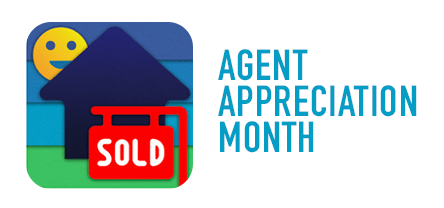 Celebrate Agent Appreciation Month and #ThankAnAgent with Inman this January. Discover more and see how to get involved, click here.
Celebrate Agent Appreciation Month and #ThankAnAgent with Inman this January. Discover more and see how to get involved, click here.
Inman Diaries is a weekly feature tracking the day-to-day activities of America’s leading real estate agents — in their own words over the course of a seven-day week. In our latest installment, Hillary Ryan, founder of the Hillary Ryan Group in Napa Valley, California, balances work, family and physical fitness in Wine Country one week before Christmas.
Sunday

8:45 a.m. Wake up, have breakfast with family. I try to take advantage of the relatively calmer weekend days to spend quality time with my husband, boys and our two dogs.
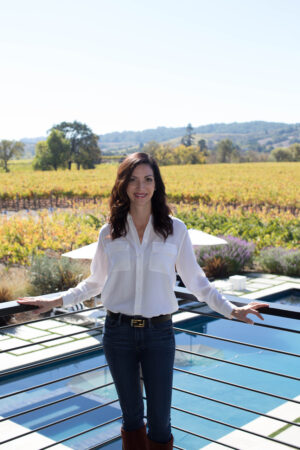
Hillary Ryan | Courtesy Hillary Ryan
10 a.m. Connect with buyer to review all information gathered in due diligence and review final steps in their vineyard estate acquisition. This is a complex $6 million property with an 8,000-square-foot home, guest house, a well, septic system, detached four-car garage, seven acres of vineyard and additional acres that could potentially be developed into a vineyard pending Napa County approvals. There are many complexities to untangle and it feels like a nice accomplishment to finalize the request for credit, which I will present to the sellers later. My excellent assistant drafts the requisite documents and sends for DocuSign on the spot.
10:30 a.m. Coffee with friends before we head over to Orangetheory together.
11:45 a.m. Exercise. I try to mix in online Peloton bike and treadmill sessions with my new favorite class, which is a combo of bike, circuit training, rowing and other exercises. I like the competitive, yet supportive nature of the group classes.
2 p.m. I get word the sellers are not comfortable with the dollar amount of the counter and they counter. I call the buyer to explain the counter offer and help him understand their point of view. I always try to explain the reasoning and perspective behind a given offer, as it often helps both parties find a reasonable compromise. Buyer agrees to credit plus an added $10,000. Fortunately, sellers agree and we are now pending! It has been a challenging transaction and I am elated to see the path towards a successful closing.
Now all we have left is to negotiate the furniture to be sold. Typically, if the buyer and seller want to include furniture as part of the sale, I try to postpone that tricky negotiation until we’re in pending status. Parties can get emotional about furniture so I work hard to separate the negotiations and remind clients to keep focused on the big ticket item: the real estate.
5 p.m. Toast to my clients with my husband — with my favorite Napa Valley bubbles — and later we have our Sunday family dinner.
Monday
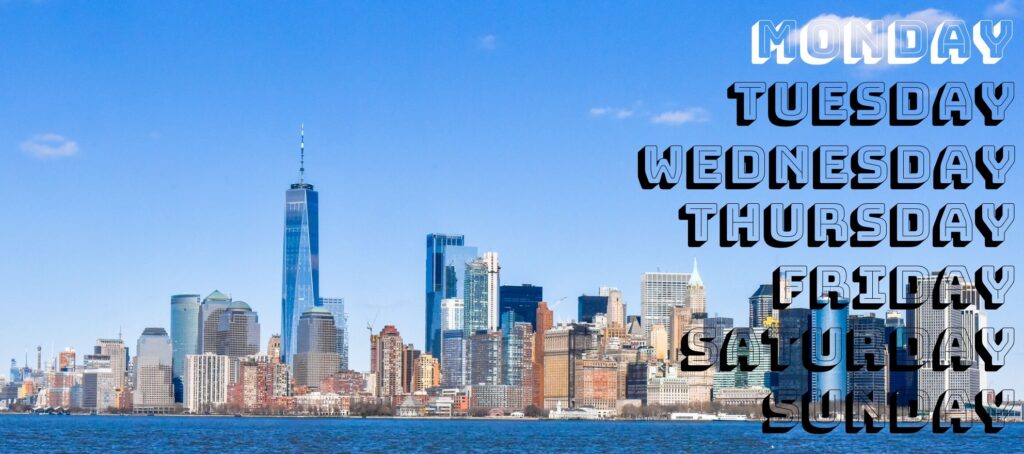
8 a.m. Connect with agents from New York regarding exciting winery referral for a contact of theirs in Hong Kong. Also, a good friend and agent based in San Francisco reached out to me to ask if I would represent their long-time friend who hopes to buy a vineyard property in Oakville. The winery referral stemmed from my social media presence. My marketing coordinator helps me stay very active on Instagram and Facebook, and it is great to have direct results!
10 a.m. Clean up my email inbox and return calls.
12 p.m. Head to Orangetheory. One of my personal goals is to exercise six times per week.
2 p.m. Office work. Meet with assistant to design and order holiday card for clients, friends, and referral partners, prepare a listing presentation for meeting scheduled for the day after Christmas. I help choose the pictures, layout, and copy. He will then upload all the addresses and order online. He will also later stamp, seal and mail them. I have amazing support!
4:30 p.m. Get final approval from lender and submit the final contingency removal to get a $4 million-plus deal pending! Working with a new lender presents opportunities for patience, as this particular one was very conservative in giving the green light to remove contingencies and it went several days past our contractual deadline. I worked hard to communicate often with the seller’s agent — the delay brought unnecessary stress to this otherwise seamless transaction.
Tuesday
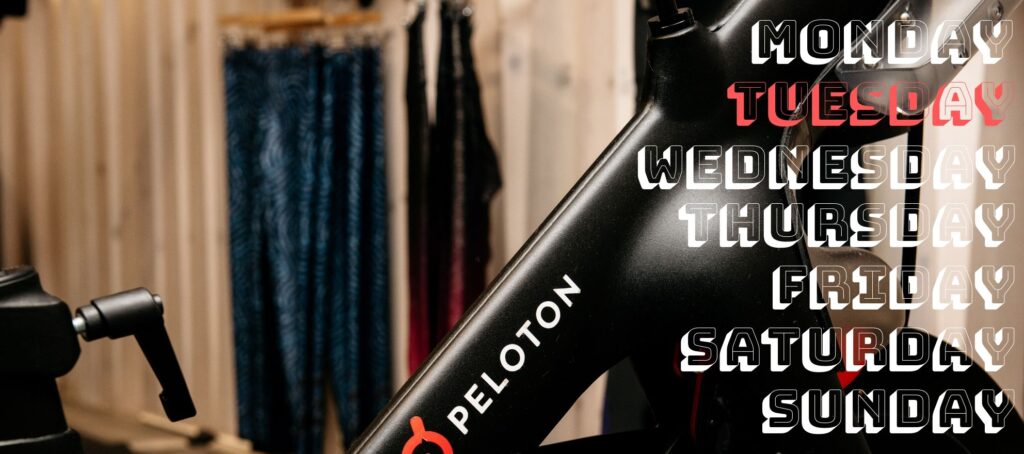
7 a.m. Hop on the Peloton bike.
8 a.m. Review disclosures with one of my favorite agents in Napa regarding her private listing, a vineyard property that produces 100-point wines. The property is an ideal match for my new client, the referral I received just yesterday.
9 a.m. Cryotherapy appointment, then hair appointment, as I draft a new listing agreement and revise copy for listing launch. It’s funny but I have to admit, my salon appointments are often when I get the most computer-based work done because I’m stuck without being able to use the telephone for at least an hour!
10:30 a.m. Drive to San Francisco for annual Realtor luncheon hosted by First Republic Bank. Connect with one past client, one active client, and one excellent referral partner. The speaker explains why he does NOT expect a recession in 2020. I have a degree in economics so I enjoy following trends and keeping current on market dynamics that will impact my clients.
2:30 p.m. Race back to Napa to meet at title company for signing with clients on $4 million property that went pending yesterday and is set to close before the holidays. They are a local family with two teenagers and I’m so thrilled because this house is a perfect fit! Meanwhile, my assistant is preparing marketing materials for a new $9 million property we’re bringing to market in the next week.
3 p.m. Take son to orthodontist and order food for the holiday dinners we’ll be hosting this year.
4 p.m. Conference call regarding a hotel listing that should launch in the spring of 2020. Hotel and commercial listings are often customized and require several iterations of review. We’re getting close to terms and I’m excited to get started with our marketing in early 2020.
6 p.m. Dinner with my (very patient) husband in Yountville to celebrate holidays, pending deals and enjoy some down-time.
Wednesday

5:45 a.m. Respond to emails, dress, finish packing, feed sons and self. My older son is in finals and his mood is less than cheery so I tried to pick up his spirits with his favorite foods. Big day ahead!
8 a.m. Drop son at school and return client calls.
9 a.m. Final walk-through with buyers. Closing is tomorrow!
10:30 a.m. Review disclosures and draft purchase documents with financial manager and attorney for vineyard estate buyer. Attorney reviews CAR draft and suggests we extend due diligence and close of escrow, but otherwise we have the green light to submit the offer.
3 p.m. Sign up family for holiday volunteering for families in need. We have an incredible colleague in our Napa Compass office who organizes toys and holiday meals for over 1,000 people in Napa County.
Thursday

7 a.m. Hop on the Peloton. Only enough time for a short ride this time.
10:30 a.m. Call family buyer to let them know they have closed escrow!
12 p.m. Holiday lunch with my amazing team. Chris, my assistant (or as he calls himself, the vice president or the COO, depending on the day), our marketing coordinator and social media manager, our administrator and our regional manager. I couldn’t survive without them! Frequent positive feedback and special holiday recognition is a must.
3 p.m. Receive a reasonable counteroffer for the large, vineyard property. Review with financial manager, recommend accepting as-is and buyer’s team agrees. Chris sends docs for signature and we are in contract!
Friday

8 a.m. Hop on the Peloton.
10:30 a.m. Unusually quiet morning. A great opportunity to catch up on administrative needs for family and work and respond to clients and colleagues.
12 p.m. Lunch meeting with a potential client. An impressive local developer is interviewing realtors for his next few luxury developments. I have a great deal of experience in the luxury spec-build segment in Napa Valley so it was a great opportunity to share ideas and vet how we would best work together.
1:30 p.m. Meet with a non-profit organization regarding a workforce housing development that is underway. Napa County has a housing shortage and the opportunity to help the community is an honor.
3 p.m. Off to the airport with my older son for a quick vacation in Hawaii. I had three conference calls set up for the drive to San Francisco International Airport (my son knows more about Napa real estate than most!).
Saturday

9 a.m. It’s the weekend . . . clients must be busy with holiday festivities and so am I! Enjoy time with son in Hawaii while sneaking in an occasional morning call to my assistant who is monitoring all deals.
Ryan is based in the Napa Valley Compass office and focuses on helping her clients transact wine country property including residential, vineyard and land development opportunities. Over the past 22 years, she has had a wide range of real estate experience including brokerage, banking and commercial real estate investment. In 2015, Ryan was recognized as one of the top 100 real estate professionals in the United States by REAL Trends. In 2017 and 2018 she was again named to the Top 200.
Inman Diaries is a weekly feature tracking the day-to-day activities of America’s leading real estate agents and brokers. To submit a diary, please send requests to Diary@Inman.com.

Are you ready for what the industry holds in 2020? Inman Connect New York is your key to unlocking opportunity in a changing market. At Connect you will gain insight into the future, discover new strategies and network with real estate’s best and brightest to a
New Fitness Center Opens At East Harlem Public Housing Complex
EAST HARLEM, NY — Free-to-use fitness equipment has been installed on the lawn of an East Harlem public housing development as part of a first-of-its-kind program run by the New York City Housing Authority, city officials announced Thursday.
NYCHA is partnering with Mount Sinai Hospital and the Trust for Public Land to install the equipment at the Carver Houses development on Madison Avenue at East 103rd Street, city officials said. The fitness facility was designed through NYCHA's Connected Communities program, which involved a two-year process of meeting with Carver residents to solicit ideas on how to best use the vacant space.
"Everyone deserves the opportunity to engage in physical fitness no matter where they live," Carter Strickland, New York State Director for the Trust for Public Land, said in a statement. "Given the rising trend of people exercising outdoors and the obstacles those in public housing face to being healthy, we teamed up with NYCHA and Mount Sinai Health Systems to provide East Harlem residents access to free exercise equipment right outside their front door."
The Trust for Public Land has partnered with municipal governments in Miami and Los Angeles to install similar fitness facilities. The Carver Houses facility is the first of its kind in New York City.
Equipment at the outdoor fitness center includes: A stationary bike, a free runner that resembles an elliptical machine, push-up and leg-lift stations, plyometric steps, triple bars for upper body training and a bench for core exercises. The triple bars are accessible for people with mobility disabilities.
NYCHA is currently seeking a partner to help run fitness programs at the site, and expects programming to begin later this year, city officials said.
"The Fitness Zone will be an important resource for residents, improving opportunities for physical activity and overall weight management, and providing an environment to encourage social support and interaction," David Reich, president and CEO of Mount Sinai Hospital, said in a statement.ccelerate your business. Create your 2020 success story at Inman Connect New York, January 28-31, 2019.
Agenda | Speakers | Past Connect Videos
Thinking of bringing your team? There are special onsite perks and discounts when you buy tickets together. Contact us to find out more.





No comments:
Post a Comment